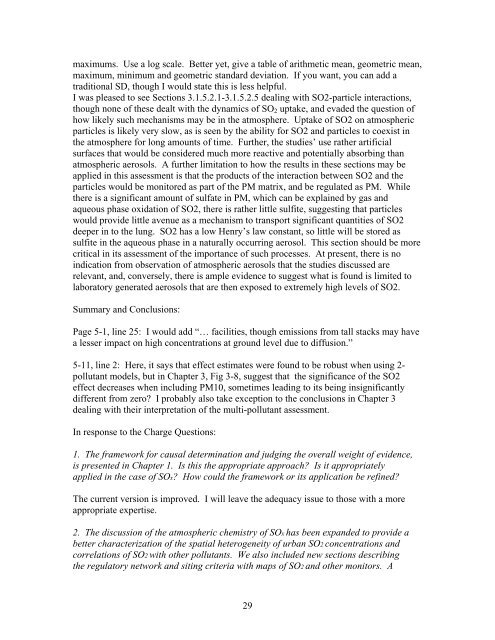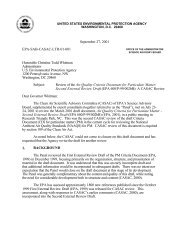(CASAC) Peer Review of EPA's Integrated Science Assessment
(CASAC) Peer Review of EPA's Integrated Science Assessment
(CASAC) Peer Review of EPA's Integrated Science Assessment
Create successful ePaper yourself
Turn your PDF publications into a flip-book with our unique Google optimized e-Paper software.
maximums. Use a log scale. Better yet, give a table <strong>of</strong> arithmetic mean, geometric mean,maximum, minimum and geometric standard deviation. If you want, you can add atraditional SD, though I would state this is less helpful.I was pleased to see Sections 3.1.5.2.1-3.1.5.2.5 dealing with SO2-particle interactions,though none <strong>of</strong> these dealt with the dynamics <strong>of</strong> SO 2 uptake, and evaded the question <strong>of</strong>how likely such mechanisms may be in the atmosphere. Uptake <strong>of</strong> SO2 on atmosphericparticles is likely very slow, as is seen by the ability for SO2 and particles to coexist inthe atmosphere for long amounts <strong>of</strong> time. Further, the studies’ use rather artificialsurfaces that would be considered much more reactive and potentially absorbing thanatmospheric aerosols. A further limitation to how the results in these sections may beapplied in this assessment is that the products <strong>of</strong> the interaction between SO2 and theparticles would be monitored as part <strong>of</strong> the PM matrix, and be regulated as PM. Whilethere is a significant amount <strong>of</strong> sulfate in PM, which can be explained by gas andaqueous phase oxidation <strong>of</strong> SO2, there is rather little sulfite, suggesting that particleswould provide little avenue as a mechanism to transport significant quantities <strong>of</strong> SO2deeper in to the lung. SO2 has a low Henry’s law constant, so little will be stored assulfite in the aqueous phase in a naturally occurring aerosol. This section should be morecritical in its assessment <strong>of</strong> the importance <strong>of</strong> such processes. At present, there is noindication from observation <strong>of</strong> atmospheric aerosols that the studies discussed arerelevant, and, conversely, there is ample evidence to suggest what is found is limited tolaboratory generated aerosols that are then exposed to extremely high levels <strong>of</strong> SO2.Summary and Conclusions:Page 5-1, line 25: I would add “… facilities, though emissions from tall stacks may havea lesser impact on high concentrations at ground level due to diffusion.”5-11, line 2: Here, it says that effect estimates were found to be robust when using 2-pollutant models, but in Chapter 3, Fig 3-8, suggest that the significance <strong>of</strong> the SO2effect decreases when including PM10, sometimes leading to its being insignificantlydifferent from zero? I probably also take exception to the conclusions in Chapter 3dealing with their interpretation <strong>of</strong> the multi-pollutant assessment.In response to the Charge Questions:1. The framework for causal determination and judging the overall weight <strong>of</strong> evidence,is presented in Chapter 1. Is this the appropriate approach? Is it appropriatelyapplied in the case <strong>of</strong> SOx? How could the framework or its application be refined?The current version is improved. I will leave the adequacy issue to those with a moreappropriate expertise.2. The discussion <strong>of</strong> the atmospheric chemistry <strong>of</strong> SOx has been expanded to provide abetter characterization <strong>of</strong> the spatial heterogeneity <strong>of</strong> urban SO2 concentrations andcorrelations <strong>of</strong> SO2 with other pollutants. We also included new sections describingthe regulatory network and siting criteria with maps <strong>of</strong> SO2 and other monitors. A29
















